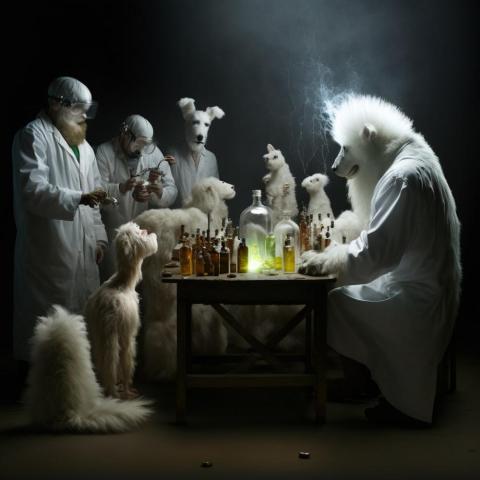On Neo-Paganism and Satanism of Modern Science
Primary tabs

The concept of “pagan” has an Old Testament origin. In Russian, “gentiles” were called peoples. The ancient Jews used the term “am” (עם) to describe themselves, and “goy” (גוי) to describe other nations. Jews = the people, it is one (chosen), and the “languages” of the nations are many. Thus the Jews themselves worshipped one God, and were sure that all other nations (tongues) worshipped many gods. Hence the identification of the term “language” (goy) with idolatrous polytheists (the Greeks have the word exactly this ειδολολάτρης). In Latin the corresponding term is gentilis from gēns, “people,” “clans,” “nations.”
This meaning was borrowed by Christians, and now the opposition was not between the Jews and everyone else, but between the Christian nations, which represent the Church of Christ, and the one “holy nation” (ὁ ἱερὸς λαὸς), and the peoples and cultures that worship many gods. They are what came to be called “pagans.” In fact, the “pagans” were the Christian nations themselves until they accepted Christ. And those nations that did not accept him and continued to worship many gods (ειδολολάτρης).
The ancient world knew almost no atheists in the modern sense, and could not imagine how it was possible to worship anyone at all. Only certain extravagant philosophers such as Democritus and Epicurus in Greece or the Charvaka-Lokaics in India (as well as other Nastic currents such as early Hinayana Buddhism) put forward the strange and outlandish hypothesis to the normal mind that “there is no God”. This was an ultra-marginal position. Interestingly, the Talmud uses the term “Epicureans” for “atheists” and “pagans.”
But there is a nuance here. Surely non-Jewish and non-Christian (as well as non-Islamic) cultures had their own understanding and interpretation of their own traditions. Many of them were convinced that they, too, worshiped the One God, and that other sacred figures were one or another of his personified attributes. Thus Plato and especially the Neoplatonists placed the One above all else, preceding all else. The Cappadocian Fathers gave evidence of the “Hipsistarians” (from θεὸς ὕψιστος, the Highest God), non-Jews who emphasized the worship of the One God. Sometimes historians of religion introduce an intermediate model of “henotheism” (literally “one-God”) – between monotheism (one-God) and polytheism (many-God). Indian advaito-vedanta emphasizes this non-divine approach in every possible way. Even the apparent dualism of Zoroastrianism still comes to the triumph of one God—Light, but such “monotheism” is dynamic and eschatological. In history, however, two beginnings are at work. And the dark one wins in the last epochs. But temporarily. Until the absolute triumph of the Light comes.
Pre-Christian and non-Christian traditions, except for the Abrahamic traditions recognized as monotheistic (Islam and Judaism), are usually called “pagan” and “polytheistic.”. Which is a definite approximation and an outsider’s view of them. Unidolatrous or not, they remain sacred and based on a belief in something “spiritual” that clearly transcends the realm of matter. Through their figures (“idols”) they appeal to incorporeal and immaterial beginnings, powers, spirits. The fact that they venerate “soulless chaff” is an acutely polemical and naive notion. Another thing is that Christianity strictly and clearly describes the structures of the spiritual world and affirms the distinction of spirits—angelic and demonic. The angelic forces are faithful to Christ, and thus guardians of Christians and the Church. So are the hosts of saints, whose images are reverently worshipped by real Christians.
However, it is ridiculous for Christians to expose “paganism” on the basis of materialistic science, which recognizes nothing but matter. The materialism that flourishes in our society today, which is inculcated in children from the time they are young, is far lower and more vulgar than paganism. It does not recognize any spiritual worlds at all, it mocks sacredness, it dissembles the world. It is crude cynicism, militant atheism and ignorance. And here is the most interesting thing: rightly criticizing paganism, modern Christians are somehow surprisingly tolerant of materialism, atomism, the scientific picture of the world, built on declarative atheism or some monstrous heresy (like Newton’s Unitarianism). The Kapishche Peruna scares (rightly) us, while a 5th grade physics textbook or Darwin’s theory of the origin of species leaves us indifferent.
This is somewhat odd. If we stand for the Christian worldview, we stand for it in everything. And the ongoing war with the West (just anti-Christian, atheistic, materialistic, satanic) is much easier to explain to Christians than to “pagans.” This is the war of the end times, where the Katechon battles Antikaimenos, the “son of perdition,” trying to postpone the coming of the Antichrist.
Furthermore, today’s “Neo-Pagans” are not from the pre-Christian tradition or non-Christian sacred cultures. They are today’s weak-minded simulacrum, founded behind centuries of misunderstanding and reenacting some ugly caricature. It is like trying to become a “fascist” by watching 17 Moments of Spring. The Ukrainian case, it seems. The truth of “neo-paganism” is that after the age of materialism, mankind is entering a post-materialist age, when armies of dark spirits, called “hordes of the Gog and the Magog” in the Bible, are invading the world to take possession of a mentally weakened humanity that has broken away from the saving Christian foundations. This invasion may take place through invented cults and delusional rituals, through institutionalized perversions, through postmodern culture and art. But it is preceded by the gigantic work of Modern civilization to uproot the Christian worldview in societies and replace it with atheistic materialism. “Neo-Paganism”—obsession, but the scientific worldview is far more toxic. Moreover, the modern variety of Satanism, including but far from limited to “neo-paganism,” was made possible precisely because of the tremendous work of philosophical, scientific, and everyday materialism. This is something to consider.
